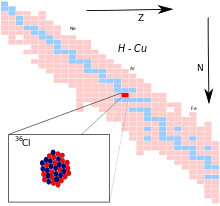 | |
| General | |
|---|---|
| Symbol | Cl |
| Names | chlorine-36, 36Cl, Cl-36 |
| Protons (Z) | 17 |
| Neutrons (N) | 19 |
| Nuclide data | |
| Natural abundance | 7×10 |
| Half-life (t1/2) | 301300±1500 years |
| Decay products | Ar |
| Decay modes | |
| Decay mode | Decay energy (MeV) |
| Beta minus | 710 keV |
| Electron capture | 120 keV |
| Electron capture | 1142 keV |
| Isotopes of chlorine Complete table of nuclides | |
Chlorine-36 (Cl) is an isotope of chlorine. Chlorine has two stable isotopes and one naturally occurring radioactive isotope, the cosmogenic isotope Cl. Its half-life is 301,300 ± 1,500 years. Cl decays primarily (98%) by beta-minus decay to Ar, and the balance to S.
Trace amounts of radioactive Cl exist in the environment, in a ratio of about (7–10) × 10 to 1 with respect to the stable chlorine isotopes. This Cl/Cl ratio is sometimes abbreviated as RCl. This corresponds to a concentration of approximately 1 Bq/(kg Cl).
Cl is produced in the atmosphere by spallation of Ar by interactions with cosmic ray protons. In the top meter of the lithosphere, Cl is generated primarily by thermal neutron activation of Cl and spallation of K and Ca. In the subsurface environment, muon capture by Ca becomes more important. The production rates are about 4200 atoms Cl/yr/mole K and 3000 atoms Cl/yr/mole Ca, due to spallation in rocks at sea level.
The half-life of this isotope makes it suitable for geologic dating in the range of 60,000 to 1 million years. Its properties make it useful as a proxy data source to characterize cosmic particle bombardment and solar activity of the past.
Additionally, large amounts of Cl were produced by irradiation of seawater during atmospheric and underwater test detonations of nuclear weapons between 1952 and 1958. The residence time of Cl in the atmosphere is about 2 years. Thus, as an event marker of 1950s water in soil and ground water, Cl is also useful for dating waters less than 50 years before the present. Cl has seen use in other areas of the geological sciences, including dating ice and sediments.
See also
References
- ^ Audi, G.; Kondev, F. G.; Wang, M.; Huang, W. J.; Naimi, S. (2017). "The NUBASE2016 evaluation of nuclear properties" (PDF). Chinese Physics C. 41 (3): 030001. Bibcode:2017ChPhC..41c0001A. doi:10.1088/1674-1137/41/3/030001.
- ^ M. Zreda; et al. (1991). "Cosmogenic chlorine-36 production rates in terrestrial rocks". Earth and Planetary Science Letters. 105 (1–3): 94–109. Bibcode:1991E&PSL.105...94Z. doi:10.1016/0012-821X(91)90123-Y.
- M. Sheppard and M. Herod (2012). "Variation in background concentrations and specific activities of 36Cl, 129I and U/Th-series radionuclides in surface waters". Journal of Environmental Radioactivity. 106: 27–34. doi:10.1016/j.jenvrad.2011.10.015. PMID 22304997.
- "Chlorine". Isotopes & Hydrology. Archived from the original on 2004-03-27.
- Paleari, Chiara I.; F. Mekhaldi; F. Adolphi; M. Christl; C. Vockenhuber; P. Gautschi; J. Beer; N. Brehm; T. Erhardt; H.-A. Synal; L. Wacker; F. Wilhelms; R. Muscheler (2022). "Cosmogenic radionuclides reveal an extreme solar particle storm near a solar minimum 9125 years BP". Nat. Commun. 13 (214). doi:10.1038/s41467-021-27891-4. hdl:20.500.11850/527622.